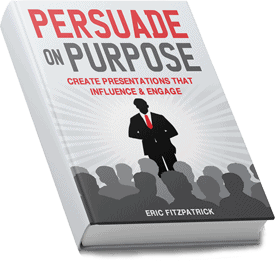In an extract from Persuade on Purpose, Eric Fitzpatrick explains the essential criteria for engaging your audience with your presentation.
Tom Peters, the management guru, says that “presentation skills are worthy of extreme obsessive study”. Whether you are selling a start-up to investors, or a new strategy to your staff, the manner in which you deliver your message will greatly impact the engagement with and adoption of it.
The latest trends in presentation-giving encourage the presenter to approach their performance in a way that is focused on persuasion and invitation to engage, rather than a revelatory or directive speech. In this extract from his new book, Eric Fitzpatrick reveals the keys to a more meaningful presentation style.
Great presentations need to meet four essential criteria. Meeting these criteria is what will help you to create and deliver a clear compelling message.
Within each of the eight presentation components (pre-presentation; opening; roadmap; message; audience engagement; delivery; close; PowerPoint slides) you will find elements that meet some or all of these criteria.
The four true criteria are:
1. THINK
Your presentation should make the audience think. They should be moved to consider the points or message you are making. Do they agree or disagree? To get them thinking, your message must be relevant to them and should offer them a new or alternative view.
2. REMEMBER
A great presentation should be easy to remember. The audience should be able to recall the key points and overriding message a day, a week, a month after the presentation has been delivered. Given that presentations are often delivered to influencers and not to the economic buyers or decision makers, it is important that influencers can recall your key points when they sit down with the economic buyer, which can be weeks after your presentation.
3. UNDERSTAND
A great presentation should be easy to understand. There should be no confusion or doubt. It should be easy to follow. It should have a logical sequence.
4. ENGAGE
A great presentation should engage the audience. It should grab their attention at the beginning and hold it throughout.
A great presentation should be easy to remember. The audience should be able to recall the key points
ENGAGING YOUR AUDIENCE
Audiences need to feel that they are part of your presentation. They need to believe that you are having a conversation with them that they can contribute to, even if they don’t contribute out loud. In many ways the aim of a presenter is to get the audience to contribute to the presentation inside the confines of their own head.
This means getting your audience to think about your presentation and how it can benefit them. It means delivering the presentation in a way that resonates with them and making sure that they don’t get distracted and start thinking about something else.
To do this, presenters need to employ ‘audience engagement techniques’. These are elements in presentations that will make some parts of your presentation stand out from the whole, which are then easier to recall a week later because of how they connected with the audience. Collectively they contribute significantly to meeting the ‘true’ criteria.
In a twenty-minute presentation a presenter will use between 2,500 and 3,000 words and the reality is that most of these words will be forgotten almost as soon as they have been said. The challenge is how as a presenter, when your words are being forgotten, do you make sure your message is remembered?
Audience engagement techniques work because they generate a reaction in the audience. Whether that reaction is physical, emotional or intellectual, it is more easily remembered than words.
If you ask an audience what they can remember about a presentation a week after they heard it, the first thing they will recall is something that applied directly to themselves. It might be that they laughed, or carried out a physical action, or made sense of something the presenter said that they then applied to their own personal circumstances. Once they recall their reaction, they can remember the relevance of that reaction and that helps them to remember your message.
As a presenter you can apply audience engagement techniques as follows:
1. By what you say. It might be a turn of phrase that stands out. It might be a phrase that is pleasant on the ear, making it memorable. Think of some of the stand-out phrases attributed to the likes of Mark Twain. For example, ‘It is better to keep your mouth shut and appear stupid, than open it and remove all doubt.’ We remember what was said because of how it was phrased.
2. By how you make your audience feel. If you say something that disgusts them, makes them angry, makes them happy or sad, or catches them by surprise, a week later they will remember that feeling more quickly than the words that generated it. Once they recall that feeling, it will be easier to recall the words, which in turn will help them remember the message.
3. By getting your audience to do something physically. A week later they will find it easier to remember something they did than something you said and, when they do, it will help them to remember why they were asked to do it, which will make it easier to recall your message.
4. By connecting your message to something they are already familiar with. Attaching your message to something that already resides within their existing bank of knowledge allows them to make sense of your message and makes it easier to recall. A week later if they are trying to recall your message, they will recall what they are already familiar with first and that will help them remember your message.
The ‘Law of Contiguity’ states that ‘when two ideas or psychologically perceived events have once occurred in close association, they are likely to occur in close association again, the subsequent occurrence of one tending to elicit the other’. Attaching your message to something your audience is already familiar with will keep them linked going forward and each time they recall one they will recall the other.
In my experience, most sales professionals don’t take the time to coat their presentation with these techniques. They focus solely on the message they want to get across without ever considering how to make sure it is listened to, understood and remembered.
Audience engagement techniques work because they generate a reaction in the audience
 TECHNIQUES TO ENGAGE YOUR AUDIENCE
TECHNIQUES TO ENGAGE YOUR AUDIENCE
Humour
Humour is a powerful tool for sales professionals. Victor Borge once said, ‘Laughter is the shortest distance between two people.’ Making an audience laugh, in an appropriate manner, goes a long way towards helping a presenter connect with them. An audience’s laughter is a signal of their acceptance of the presenter or the presenter’s point of view. This acceptance makes it easier for them to buy into a presenter’s ideas.
Laughter is an internal reaction to an external stimulus and when trying to recall the details of a presentation a day, a week or a month after it was delivered, we find it easier to remember our internal reactions. Once we remember the internal reaction it becomes easier to remember the information that generated that reaction.
Humour engages an audience and holds their attention. That said, for many presenters, making an audience laugh can be challenging. Some presenters believe that they are not funny, while others are afraid that audiences won’t laugh where they are supposed to.
The good news is that anyone can learn to be funnier, can learn how to inject humour into presentations. Of course, sometimes audiences won’t laugh when you want them to and will laugh when you weren’t expecting them to. That said, the reward when you get an audience to laugh is definitely worth the risk.
A story
Stories are the most powerful tool a presenter can use when creating a presentation to meet the true criteria. Nothing connects as effectively, aids recall, promotes understanding or captures an audience’s attention with the same impact as a well-told story.
Stories are part of our DNA. It is how we have transferred information and learning for thousands of years. It is one of the first mediums we use to teach children from an early age and it is the medium we use to share information on a daily basis and yet, for some reason, when it comes to delivering presentations, we choose not to apply this tried and tested method. Instead we stick to facts, figures and statistics (more about these below). Stories connect emotionally and are more powerful for doing so.
Dialogue
Dialogue is a tool that can be used by a presenter to reinforce a point they are trying to make. It works when the presenter decides to become the person or persons in the example they are using to make that point.
Instead of just giving the example as something that happened in the past, dialogue allows the presenter to deliver the example as if it is taking place in front of the audience. This changes how the audience receives it. They become more active when they feel that the story is unfolding in front of them and this increases the impact of the message.
Stories connect emotionally and are more powerful for doing so
As an example of dialogue, I tell a story about my eight-year-old nephew. I use this story to illustrate that on occasion we can all make an assumption that we know the correct answer to a question or problem, but then discover that our assumption is wrong.
The story goes like this: One day my nephew was sitting at the dinner table with the rest of his family when his mother decided to explain who the Suffragettes were. She looked at him and said, ‘There was a time in history when men could vote and women couldn’t and a group of women got together to address this terrible injustice.’ She then asked her son a question: ‘Do you know what those women were called?’ Her son looked at her confidently and said, ‘I do, mum. They were called prostitutes.’
When giving this example I become the mother (and give her a distinctive voice) and deliver her words as if I am her. I then become the son (and give him a different voice) and deliver his reply as if I am him. The dialogue brings the example to life in front of the audience, which increases the impact of the message.
A question
Questions are a powerful tool for engaging your audience. Questions get them thinking, and when they are doing that they are fully focused on your topic. Presenters can ask questions that require the audience to answer verbally, to answer with a gesture or action, or just to consider the answer in their own heads.
Questions promote understanding, as they allow the audience to derive their own answers. They also make your message easier to remember because it makes them active participants in your presentation.
A full range of questions are available to the presenter, from closed questions that generate a ‘yes’ or ‘no’ answer, to open questions that require a more detailed answer. Probing questions such as ‘What exactly do you mean by …?’ can also be asked, or hypothetical questions such as ‘What would happen if …?’ or ‘How would we handle the following situation?’

Eric Fitzpatrick
Audience involvement
Getting your audience to physically do something during your presentation is a very effective means of engaging them. It also helps to create understanding and makes your message easier to remember.
There are many techniques for getting your audience to do something during a presentation.
For example when demonstrating how easy it is for our message to be misunderstood, I will often ask audiences to tear a piece of paper by following a set of instructions. I give everyone a plain sheet of A4 paper and ask them to hold the sheet in both hands and close their eyes.
I then ask them to fold the piece of paper in half and, once done, ask them to tear off the right-hand corner. They repeat the action of folding and tearing another three times. They then open out their sheet of paper, open their eyes and hold up the sheet for everyone to see. In spite of the fact that everyone received the same instructions the audience members always end up with a plethora of vastly different results.
There are two reasons for this. The first reason is due to how they interpret my instructions and the second is due to the lack of clarity of those instructions.
Another useful audience participation exercise is to ask members of the audience to draw an image on a flip chart.
There are many different types of activities available to a presenter. Spending a little bit of time finding appropriate activities and practising getting comfortable with using them will add significantly to the impact of your presentation. I have had audience members meet me months later and comment that they can still remember the activity or action I asked them to get involved in.
Image (main): Designed by Freepik
About the author: Eric Fitzpatrick is a speaker, trainer and coach. Visit arkspeakingandtraining.com for more information.







